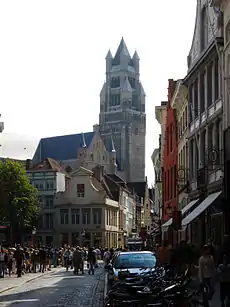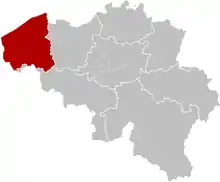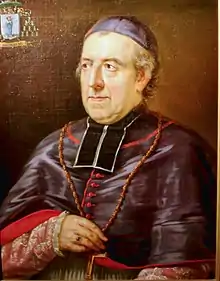Roman Catholic Diocese of Bruges
The Diocese of Bruges, (Bisdom Brugge in native Dutch) is a Latin Church ecclesiastical territory or diocese of the Catholic Church in Belgium. It is a suffragan in ecclesiastical province of the metropolitan Archdiocese of Mechelen-Brussels, which covers all of Belgium.
Diocese of Bruges Dioecesis Brugensis Bisdom Brugge (Dutch) Diocèse de Bruges (French) Bistum Brügge (German) | |
|---|---|
 | |
| Location | |
| Country | Belgium |
| Ecclesiastical province | Mechelen-Brussels |
| Metropolitan | Archdiocese of Mechelen-Brussels |
| Statistics | |
| Area | 3,145 km2 (1,214 sq mi) |
| Population - Total - Catholics (including non-members) | (as of 2018) 1,190,193 841,900 (70.7%) |
| Information | |
| Denomination | Catholic Church |
| Sui iuris church | Latin Church |
| Rite | Roman Rite |
| Established | 12 May 1559 |
| Cathedral | St. Salvator's Cathedral in Bruges |
| Current leadership | |
| Pope | Francis |
| Bishop | Lodewijk Aerts |
| Metropolitan Archbishop | Jozef De Kesel |
| Bishops emeritus | Roger Vangheluwe |
| Map | |
 The diocese of Bruges, coextensive with the province of West Flanders | |
| Website | |
| https://www.kerknet.be/organisatie/bisdom-brugge | |
Previously a diocese from 1558 to its suppression in 1801 during the Napoleonic and Dutch era, it was restored in 1834 a pre-diocesan stage as an apostolic vicariate in 1832.[1] Its territory coincides with West Flanders.
Its cathedral is the Sint-Salvator Cathedral, dedicated to Our Savior, in Bruges (Brugge), West Flanders province, a minor basilica. Its patron saint however is Saint Donatian, hence the cathedral is also known as Sint-Salvators- en Donaaskathedraal after both saints.
Statistics
As of 2014, it pastorally served 965,000 Catholics (82.1% of 1,174,752 total) on 3,145 km² in 362 parishes and 65 missions with 708 priests (499 diocesan, 209 religious), 91 deacons, 1,986 lay religious (290 brothers, 1,696 sisters) and 7 seminarians.
History
An earlier diocese of Bruges was established on 12 May 1558, on territory split off from the Diocese of Tournai, as part of the great Habsburg reform of the church in the then Spanish Low Countries. Its cathedral see, St. Donatian's Cathedral, was destroyed in a fire in 1799 during the aftermath of the French Revolution.
During the Napoleonic Concordate-period reforms, it was suppressed on 1801.07.15 and its territory merged into the Diocese of Ghent (Gent).
On 17 December 1832, shortly after the independence of Belgium, it was restored as (pre-diocesan) Apostolic Administration of West Flanders ('West-Vlaanderen', the name of the Belgian province it coincides with, as most Belgian bishoprics), regaining its territory from Ghent. On 27 May 1834, this was promoted to Diocese again and renamed after its see, Brugge, while the incumbent Apostolic Administrator was promoted Suffragan Bishop. On 31 May 1967 it lost a bit of territory to the Ancient Diocese of Tournai, shortly after a reshuffle of province borders involving a few municipalities, notably Moeskroen being transferred to Hainaut (which Tournai bishopric covers).
In 1985 the diocese enjoyed a papal visit from Pope John Paul II, who on 17 May gave a homily on the horrors of war at Ypres as part of his pastoral visit to the Low Countries.[2]
A pederasty scandal saw its self-confessed, hardly remorseful bishop Roger Vangheluwe forced into 'early emeritate', traumatizing the entire Belgian church.
Ordinaries


- Suffragan Bishops (first diocese)
- 1560–1567: Petrus Curtius (Petrus De Corte)
- 1569–1594: Remigius Driutius
- 1596–1602: Mathias Lambrecht
- 1604–1616: Charles Philippe de Rodoan
- 1616–1620: Anthonius Triest (also bishop of Ghent)
- 1623–1629: Denis Stoffels
- 1630–1639: Servaas de Quinckere
- 1642–1649: Nicolaas de Haudion
- 1651–1660: Carolus van den Bosch (afterwards bishop of Ghent)
- 1662–1668: Robert de Haynin
- 1668–1671: Charles Geleyns
- 1671–1681: François de Baillencourt
- 1682–1689: Humbertus Guilielmus de Precipiano (also Archbishop of Mechelen)
- 1691–1706: Guilielmus (Willem) Bassery
- 1706–1716: Vacant
- 1716–1742: Hendrik Jozef van Susteren
- 1743–1753: Jan-Baptist de Castillon
- 1754–1775: Joannes-Robertus Caimo
- 1777–1794: Felix Brenart
- Suppressed
- Apostolic Administrator of West Flanders
- François-René Boussen (January 21, 1833 – May 27, 1834 see next), Titular Bishop of Ptolemais (December 17, 1832 – June 23, 1834), Coadjutor Bishop of Ghent (Belgium) (December 17, 1832 – June 23, 1834)
- Suffragan Bishops (present diocese)
- 1834–1848: François-René Boussen (see previous)
- 1848–1864: Joannes-Baptista Malou
- 1864–1894: Johan Joseph Faict
- 1894–1895: Petrus De Brabandere
- 1895–1931: Gustavus Waffelaert
- 1931–1952: Henricus Lamiroy
- 1952–1984: Emiel-Jozef De Smedt
- 1984–2010: Roger Joseph Vangheluwe
- 2010–2015: Jozef De Kesel, later promoted Metropolitan Archbishop of Mechlin-Brussels
- 2016–present: Lode Aerts
Notes
- "Diocese of Brugge {Bruges}". Catholic-Hierarchy.org. David M. Cheney. Retrieved 23 January 2015.
- "17 maggio 1985, Solenne Celebrazione a Ieper | Giovanni Paolo II". w2.vatican.va.
External links and sources
![]() Media related to Roman Catholic Diocese of Brugge at Wikimedia Commons
Media related to Roman Catholic Diocese of Brugge at Wikimedia Commons